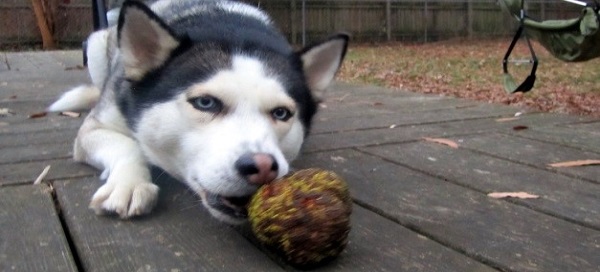.jpg)
Photo by John Lillis
Across from the Great Barn at Horton Grove Nature Preserve, there is a stand of trees with a mysterious fruit that dates back to the last ice age. This bright green fruit is about the size of a softball, with a texture similar to that of a cat’s tongue. This mystery fruit belongs to the Osage-orange tree, which according to modern field guides has a limited natural range in the Red River region in Texas, Oklahoma, and Arkansas. Native Americans, European settlers, and 19th century farmers all helped spread the tree to the 39 states it’s found in today.
Why am I writing a blog about this particular tree? Well, a few minutes of searching it on Google revealed many interesting secrets and stories. With the “native” range of Osage-orange so small, my initial research set out to answer the question: if Osage-orange does so well elsewhere, why was it restricted to such a small area? The history that unfolded before me ranked pretty high on my cool story scale.
The answer, researchers say, is in the disappearance of what was once the fruit’s primary dispersers. Mammoths, ground sloths, and other megafauna in the time before the last Ice Age were responsible for the transportation and spread of the tree. Fossil evidence shows that Osage-oranges could be found across the Midwest and eastern United States, and north up to Ontario (much like it is today), and that there were seven, not just one, species in the Osage-orange genus. When the megafauna which ate the fruit went extinct, no critter in North America had interest in consuming the fruit, and thus, with no natural spread, its range shrank to the Red River region that defines its current natural range.
What brought about the new-age spread of this species? In the past few centuries, the trees were used in the Midwest as an alternate to fencing before the invention of barbed wire, hence why “Hedge Apple” is a common name for it. These trees were hardy enough to survive frequent and poor pruning, which was done to promote bushy growth as saplings. The final product of this was a live fence which was “horse high, bull strong, and hog tight.” It is also rumored that the fruit can repel spiders and insects from your house. While Iowa State University has done research showing that chemicals present in the fruit do repel cockroaches, there is no conclusive evidence that the fruit is a successful insect repellant.
What about the future of the great Osage? Well, it could literally be a bright one. Research shows that the wood contains the most amounts of BTUs per cord over any other tree in our region. It releases 32.9 million BTUs per cord, which is equal to approximately 250 gallons of heating oil per cord burned. Furthermore, they will always have a future in the craft industry. Bowmakers for years have used the wood because of its high level of strength and dimensional stability when under strain. It’s also catching on as the wood of choice for many string instruments, such as guitar, mandolins, and even harpsichords.

Shyli was not amused by her new “treat.”
So ends my salute to the Osage-orange, one of the few trees that can be categorized by “the tree that misses the mammoth.” This is the latest edition of The Dirt: Tales from the Field, a blog from us at TLC to y’all, the supporters and friends of conservation. If you ever have any questions about what we do, or any suggestions for a future blogging subject, feel free to send them my way at [email protected]. Thank you and happy hiking!
